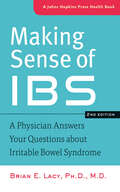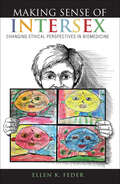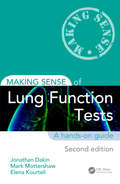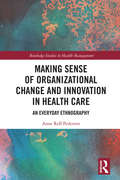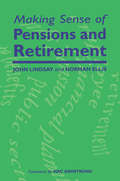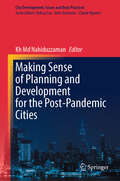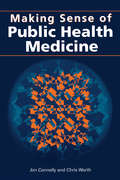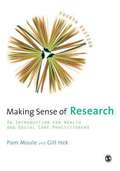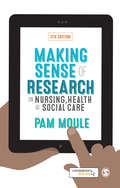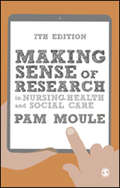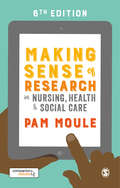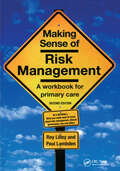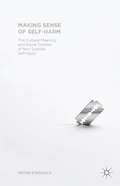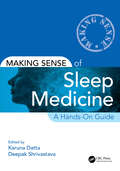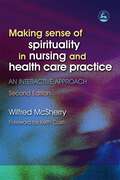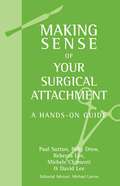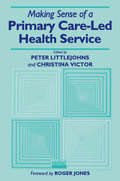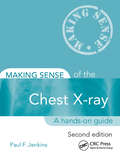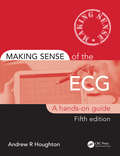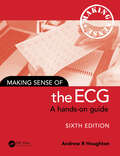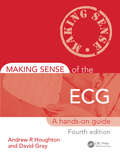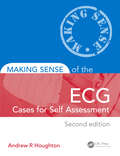- Table View
- List View
Making Sense of IBS: A Physician Answers Your Questions about Irritable Bowel Syndrome (A Johns Hopkins Press Health Book)
by Brian E. LacyVital information about new treatments and dietary factors affecting irritable bowel syndrome.IBS, which affects almost one in six Americans, is characterized by abdominal pain, bloating, gas, and diarrhea or constipation. Today more than ever before, physicians are able to diagnose this complex disorder, understand and explain its origins, and develop a treatment plan that effectively meets the individual needs of a patient.Drawing on his many years of experience treating people who have symptoms of IBS, Dr. Brian E. Lacy explains normal digestion, the causes of IBS, how IBS is diagnosed, and what to expect with treatment. He also explores special topics such as IBS in children and psychological, hypnotherapeutic, and psychiatric therapies. Important new information in the second edition includes• The roles of fiber, gluten, lactose, and fructose in the development and treatment of IBS• The use of probiotics and antibiotics to treat IBS• Similarities and differences between IBS and inflammatory bowel disease (IBD)• The relationship between small intestine bacterial overgrowth and IBS• How to make the most of your visits to a gastroenterologist• Lifestyle modifications that can improve symptoms of IBSMaking Sense of IBS is an essential resource for anyone who has symptoms or a diagnosis of IBS as well as for health professionals who treat people with this complex disorder.
Making Sense of Intersex: Changing Ethical Perspectives in Biomedicine
by Ellen K. FederA philosopher offers a framework for the treatment of intersex children, and a moral argument for responsibility to them and their families.Putting the ethical tools of philosophy to work, Ellen K. Feder seeks to clarify how we should understand “the problem” of intersex. Adults often report that medical interventions they underwent as children to “correct” atypical sex anatomies caused them physical and psychological harm. Proposing a philosophical framework for the treatment of children with intersex conditions—one that acknowledges the intertwined identities of parents, children, and their doctors—Feder presents a persuasive moral argument for collective responsibility to these children and their families.“In a voice both urgent and nuanced, Feder squarely faces the complexities that accompany the care of people with atypical sex anatomies in medical science. . . . Rich with cross-discipline potential, Feder’s engaging argument should provide a new approach for doctors and parents caring for children with atypical sex anatomy.” —Publishers Weekly, starred review“Feder’s book is a welcome injection of new ideas into feminist scholarship on intersex, post-Consensus Statement era.” —Women’s Review of Books“Is a work of philosophy capable of bringing insightful new perspectives or illuminating and forceful arguments to an urgent social matter so as truly to effect a felt change in the lives of people concerned by it? Feder’s book is capable of this effect. As such, it takes the risk of calling forth a new public, or a new readership, and so is a work whose appeal could well be ahead of its time. But its time should be here.” —International Journal of Feminist Approaches to Bioethics“Making Sense of Intersex significantly enhances our understanding of intersex and the ethical issues involved in medical practice more generally.” —Kennedy Institute of Ethics Journal
Making Sense of Lung Function Tests (Making Sense of)
by Jonathan Dakin Mark Mottershaw Elena KourteliRespiratory problems are the most common cause of acute admission to hospital. A variety of diagnostic investigations are required, both for acute and clinic assessment. Making Sense of Lung Function Tests, Second Edition familiarises both trainees and more experienced clinicians with the interpretation of a range of respiratory parameters. It places lung function in a clinical context using real-life examples and provides invaluable hands-on guidance. For this second edition Consultant Respiratory Physician Jonathan Dakin and Consultant Anaesthetist Elena Kourteli are joined by Mark Mottershaw, Chief Respiratory Physiologist from Queen Alexandra Hospital, Portsmouth, all contributing a broad range of expertise and perspectives. Together they have updated the book throughout and added new chapters including an algorithm for interpretation of pulmonary function tests, exhaled nitric oxide (FENO) and cardiopulmonary exercise testing. The text offers a clear explanation of the concepts which students find difficult, including: The basis of obstructive and restrictive defects Pattern recognition of the flow volume loop Differences between TLCO and KCO Assessment of oxygenation using PO2 and SO2 The basis of Type 1 and type 2 respiratory failure Distinguishing respiratory and metabolic acidosis The relationship between sleep and respiratory failure The information is presented in an accessible way, suitable for those seeking a basic grounding in spirometry or blood gases, but also sufficiently comprehensive for readers completing specialist training in general or respiratory medicine.
Making Sense of Organizational Change and Innovation in Health Care: An Everyday Ethnography (Routledge Studies in Health Management)
by Anne Reff PedersenThis book explores the hospital via organisational ethnography (OE), an approach that involves a mix of fieldwork methods designed to analyse the hospital which also includes participatory observation, qualitative interviews and shadowing. One way to define a hospital is by its high level of formal organisation, resulting in written or digital communication as the main source of communication in patient journals, minutes and medical and quality guidelines. In contrast, in this book, the aspects of the informal organisation will be the focus. In spite of the many formal regulations of healthcare, hospitals are also chaotic organising places where many different groups of people interact in order to negotiate, to practice and to make sense of daily work tasks. The underlying argument is that, in the mundane everyday life of hospitals, frontline workers and their interactions with patients and local managers remain at the core of organising hospitals. The overall purpose of this book is to report stories back from the field of healthcare, demonstrating how people, spaces and work (as examples of events) become important elements of organising hospitals. The book will be of interest to students and scholars in and across healthcare management, organisation studies, ethnography, sociology, qualitative methods, anthropology, service management and cultural studies.
Making Sense of Pensions and Retirement
by Norman Ellis John LindsayThe NHS pension scheme is the largest in Europe. This guide explains how it works and how to maximize its benefits and avoid its pitfalls. The book covers: recent changes to the scheme including new provisions for early retirement; personal pensions, financial planning and investment options; advice on preparing for retirement and working after retirement; state benefits; and health and leisure in retirement. It is written for all NHS staff and should be of particular value to GPs and salaried doctors.
Making Sense of Planning and Development for the Post-Pandemic Cities (City Development: Issues and Best Practices)
by Kh Md NahiduzzamanThis book holds a distinguished promise of an intellectual understanding and complete account of that shifts in laying out resilient planning, development, and policy landscapes for the cities to come. The approach offers a unique perspective on planning and development in the post-pandemic era, addressing the interconnectedness of diverse spatial, social, cultural, economic, demographic, and political aspects. It provides insights into the transformational behavior of cities and citizens, explores the influence of remote work on the real estate market, emphasizes the need for resilient infrastructure and adaptive planning, and reinforces the association between health infrastructure and planning for resilient cities. The book provides a comprehensive account of the shifts and challenges faced in planning and development due to climate change and the COVID-19 pandemic. It explores transformational urban planning, sociocultural, and economic landscapes and addresses topics, including land use changes, transformational real estate market, urban recreational space, adaptive infrastructure, and the need for resilient planning. It offers valuable insights for urban designers, architects, geographers, city planners, policymakers, and pubic officials seeking to enhance city resilience in the post-pandemic era. The intended readership of the book includes urban designers, architects, city planners, geographers, policy makers, and public officials. It caters to individuals interested in gaining a critical understanding of the interconnectedness between various spatial, social, cultural, economic, demographic, and political aspects. The content level is academic, offering scholarly insights and a unique post-pandemic perspective on enhancing city resilience.
Making Sense of Public Health Medicine
by Jim Connelly Chris WorthThis book presents an introduction to modern public health seen from the perspective of practitioners of public health medicine. Written for non-practitioners interested in public health and as an essential introduction for those considering a career in public health medicine, the book uses illustrative case studies to demonstrate the practical application of public health techniques. In demonstrating the value of this approach, the book argues for the adoption of a realist health policy and radical reform of clinical medicine - to achieve public health. The skills of public health physicians are central to planning health services, purchasing effective and cost-effective treatments, and improving the quality of services. It is vital that those who plan and deliver health care understand their work and appreciate their contribution. This book describes that contribution, and provides a powerful analysis of the challenges the NHS and the wider community face in improving health.
Making Sense of Research
by Pam MouleTo help health and social care professionals develop research literacy, this introductory text overviews the relevant elements of evidence-based practice from key terms and concepts to research dissemination and implementation. The text includes highlighted key points, further reading, appended material on conducting literature searches and appraising a study, and a glossary. The references include a listing for each of the authors; that of Moule is her doctoral thesis at the U. of the West of England, Bristol. Hek's professional affiliation is not given. A Web search shows the dates of previous editions to be 2002 and 1996. Annotation ©2006 Book News, Inc. , Portland, OR (booknews. com)
Making Sense of Research in Nursing, Health and Social Care
by Pam MouleWhat is research? Why is it important in health and nursing? How should students use evidence in practice? This short and simple book for those who are completely new to research will answer all your students' questions about the subject. It will help them to make sense of the various and often confusing research methods and terminology, to read and appraise literature and to understand how research is implemented in practice. It features: · Case examples of real research from a variety of settings and a range of countries so that students can see how research applies to the real world · Tools, examples and frameworks to help students to find, appraise and critique research · Chapter learning outcomes and key points to help students to remember important information · A companion website with interactive glossary and reflective exercises to help students test their knowledge and apply it to practice, printable step-by-step frameworks for use when searching for or critiquing a paper, and direct links to relevant SAGE journal articles and weblinks. · Further resources for lecturers are available, including all the practice examples from the book, seminar question ideas and critical appraisal powerpoints. The book is essential reading for undergraduate and postgraduate students of nursing and health in the UK and internationally.
Making Sense of Research in Nursing, Health and Social Care
by Pam MouleWhat is research and how does it work in the context of nursing, health and social care? This introductory guide provides you with a concise overview of the different research methods and terminology that you will come across when undertaking research in any course related to nursing, health and social care. The book′s easy-to-follow structure takes you from research novice to confident researcher, helping you to make sense of research and understand how it is implemented in healthcare practice. The new edition includes: Updates in light of the 2018 NMC standards, with more information on the impact of GDPR, consent and vulnerable groups, Personal and Public Involvement (PPI), and work-based projects. Improved case examples of real research, with more on group work, poster presentations, research output and dissemination, literature reviews, and dissertations. Upgraded activities that include reflective exercises, critical appraisal tools, a dissemination plan, and a glossary, all in the book. This is essential reading for undergraduate and postgraduate students within the health and therapy professions, nurses, midwives, physiotherapists, radiographers, occupational therapists, speech and language therapists, and paramedics.
Making Sense of Research in Nursing, Health and Social Care
by Pam MouleWhat is research and how does it work in the context of nursing, health and social care? This introductory guide provides you with a concise overview of the different research methods and terminology that you will come across when undertaking research in any course related to nursing, health and social care. The book′s easy-to-follow structure takes you from research novice to confident researcher, helping you to make sense of research and understand how it is implemented in healthcare practice. The new edition includes: Updates in light of the 2018 NMC standards, with more information on the impact of GDPR, consent and vulnerable groups, Personal and Public Involvement (PPI), and work-based projects. Improved case examples of real research, with more on group work, poster presentations, research output and dissemination, literature reviews, and dissertations. Upgraded activities that include reflective exercises, critical appraisal tools, a dissemination plan, and a glossary, all in the book. This is essential reading for undergraduate and postgraduate students within the health and therapy professions, nurses, midwives, physiotherapists, radiographers, occupational therapists, speech and language therapists, and paramedics.
Making Sense of Research in Nursing, Health and Social Care
by Professor Pam MouleWhat is research? Why is it important in health and nursing? How should students use evidence in practice? This short and simple book for those who are completely new to research will answer all your students’ questions about the subject. It will help them to make sense of the various and often confusing research methods and terminology, to read and appraise literature and to understand how research is implemented in practice. It features: · Case examples of real research from a variety of settings and a range of countries so that students can see how research applies to the real world · Tools, examples and frameworks to help students to find, appraise and critique research · Chapter learning outcomes and key points to help students to remember important information · A companion website with interactive glossary and reflective exercises to help students test their knowledge and apply it to practice, printable step-by-step frameworks for use when searching for or critiquing a paper, and direct links to relevant SAGE journal articles and weblinks. · Further resources for lecturers are available, including all the practice examples from the book, seminar question ideas and critical appraisal powerpoints. The book is essential reading for undergraduate and postgraduate students of nursing and health in the UK and internationally.
Making Sense of Research in Nursing, Health and Social Care
by Professor Pam MouleWhat is research and how does it work in the context of nursing, health and social care? Now in its 6th edition, this easy to read guide keeps on providing a concise overview of the different research methods and terminology and helps readers understand how research is implemented in practice. The new edition includes: o Case examples of real research from a variety of settings and countries o Updates in light of the new NMC standards, more on critical appraisal tools and service improvement o Chapter learning outcomes and key points o A companion website featuring an interactive glossary, reflective exercises and free access to SAGE journal articles for students, as well as SAGE videos and seminar notes for lecturers and more This is essential reading for undergraduate and postgraduate students of nursing and health in the UK and internationally.
Making Sense of Research in Nursing, Health and Social Care
by Professor Pam MouleWhat is research and how does it work in the context of nursing, health and social care? Now in its 6th edition, this easy to read guide keeps on providing a concise overview of the different research methods and terminology and helps readers understand how research is implemented in practice. The new edition includes: o Case examples of real research from a variety of settings and countries o Updates in light of the new NMC standards, more on critical appraisal tools and service improvement o Chapter learning outcomes and key points o A companion website featuring an interactive glossary, reflective exercises and free access to SAGE journal articles for students, as well as SAGE videos and seminar notes for lecturers and more This is essential reading for undergraduate and postgraduate students of nursing and health in the UK and internationally.
Making Sense of Risk Management: A Workbook for Primary Care, Second Edition
by Roy Lilley Paul LambdenWhat you really need to know about risk management, clinical governance, law and ethics… Now completely revised and updated Making Sense of Risk Management: a workbook for primary care breaks down complex issues and presents them in an easily comprehensible manner. Addressing current issues such as the new GP Contract and the rapid rise in litigation, this new edition takes on a more rigorous approach but maintains the same light-hearted style with more detailed and definitive guidance. The format makes use of tips, warnings, tables, exercises and think boxes providing an informative, interesting and engaging read. All primary care staff including General Practitioners, managers, nurses, health visitors, administrative staff and receptionists will find this book invaluable.
Making Sense of Self-harm: The Cultural Meaning And Social Context Of Non-suicidal Self-injury
by Peter SteggalsMaking Sense of Self-Harm provides an alternative approach to understanding nonsuicidal self-injury; using Cultural Sociology to analyse it more as a practice than an illness and exploring it as a powerful cultural idiom of personal distress and social estrangement that is peculiarly resonant with the symbolic life of late-modern society.
Making Sense of Sleep Medicine: A Hands-On Guide (Making Sense of)
by Karuna Datta Deepak ShrivastavaThis is a practical and patient-complaint focused handbook, directed to motivate non-sleep experts and beginners in sleep medicine and technology. This book provides a basic review of the area of sleep, identifies some common patient presentations and illustrates the types of investigations that should be requested. With sleep and breathing problems being so common and affecting many other chronic clinical conditions, it is important that primary care and other general physicians as well as allied health practitioners have a greater appreciation of this area. This text is a valuable “go-to” handbook for the occasional “sleep” practitioner to refer to. Key Features:• Contains specially packaged with Specific Learning Objectives to each chapter followed by self-assessment questions, case scenarios, basic sleep monitoring techniques in detail with sample reports.• Provides direction to health care professionals who encounter patients with sleep and breathing disorders in their practice.• Uses algorithms and concept maps for dealing with specific symptoms.
Making Sense of Spirituality in Nursing and Health Care Practice: An Interactive Approach Second Edition
by Wilf Mcsherry'This is a well-written and useful book, particularly for those healthcare professionals who, with a little more confidence, and perhaps some Chaplaincy support, are well able to support their patients on their spiritual journeys. It would be an excellent tool for learning sessions between Chaplaincy and nursing staff, along with other relevant professional groups.' - Signpost 'This book considers why the spiritual needs of individuals are important. In an attempt to explain, the book uses case studies, which show the relationship of theory to practice. It is an interactive book encouraging reflection to explore the meaning of spirituality to patients and health care professionals. The exercises also attempt to explain the importance of a team approach to spiritual assessment as part of a holistic assessment. The book gives clear explanations of spirituality in the context of Holism and the different sections give plenty of food for thought. There are excellent references and suggestions for further reading. It is not a book for light reading but would be invaluable when encountering difficulties with a spiritual assessment or situation.' - Journal of Community Nursing Caring for the spiritual needs of patients is a highly significant yet often neglected and misunderstood aspect of health care. This results, in part, from a general lack of guidance and instruction given to healthcare professionals on the subject. This new edition of an established introductory guide to spirituality and health care practice draws extensively on case studies illustrating the application of theory to practice. It encourages the exploration, through reflective activities, of what spirituality means, both to patients and to the healthcare professionals caring for them. This book provides a comprehensive introduction to spiritual care for heath care professionals in all areas of practice.
Making Sense of Your Surgical Attachment: A Hands-On Guide
by David Lee Rebecca Lee Paul Sutton Polly Drew Michelle ChimentiYour surgical attachment is fast approaching and you have a number of questions that need answering to help you make the most of your experience... Making Sense of Your Surgical Attachment will answer them for you. Everything you need to know about the operating theatre and the use of surgical instruments is packed into this one handy guide:* The n
Making Sense of a Primary Care-Led Health Service
by Christina R. Victor Peter LittlejohnsThe shift of services from acute hospitals to general practice requires clinicians to become actively involved in the process of change. This book sets out to demonstrate that with careful planning, implementation and evaluation of this process, problems can be avoided and the quality of service enhanced. The authors demonstrate a clear understanding of the practical issues involved and their evident enthusiasm for the opportunities now available will stimulate innovation in hospital staff, the health care team in general practice and NHS managers responsible for the delivery of a more efficient and responsible service.
Making Sense of the Chest X-ray: A hands-on guide (Making Sense Of Ser.)
by Paul JenkinsWhen a patient presents to the emergency department, in the GP practice, or in the outpatient clinic with a range of clinical signs, the chest x-ray is one of the most valuable diagnostic tools available to the attending physician. Accurate interpretation and understanding of the chest x-ray is therefore a crucial skill that all medical students an
Making Sense of the ECG: A Hands-On Guide (Making Sense of)
by Andrew HoughtonInterpreting an ECG correctly and working out what to do next can seem like a daunting task to the non-specialist, yet it is a skill that will be invaluable to any doctor, nurse or paramedic when evaluating the condition of a patient. Making Sense of the ECG has been written specifically with this in mind, and will help the student and more experienced healthcare practitioner to identify and answer crucial questions. This popular, easy-to-read and easy-to-remember guide to the ECG as a tool for diagnosis and management has been fully updated in its fifth edition to reflect the latest guidelines.
Making Sense of the ECG: A Hands-On Guide (Making Sense of)
by Andrew HoughtonInterpreting an ECG correctly and working out what to do next can seem like a daunting task to the non-specialist, yet it is a skill that will be invaluable to any doctor, nurse or paramedic when evaluating the condition of a patient.Making Sense of the ECG has been written specifically with this in mind and, across multiple editions, has helped students and more experienced healthcare practitioners to identify and answer crucial questions, including:Are these abnormalities significant?How do I distinguish between VT and SVT?Does this patient have an acute coronary syndrome?How do I measure the QT interval?Should I refer this patient to a cardiologist?This popular, easy-to-read and easy-to-remember guide to the ECG as a tool for diagnosis and management has been fully updated in its sixth edition to reflect the latest guidelines, with new chapters added: ‘Reading an ECG Recording’ and 'Ten ECGs Not to Miss’.Key features: Real ECGs – with annotation throughout to highlight key features and new examples included Strong clinical emphasis – for rapid reference in the emergency department, ward or outpatient setting with increased focus on urgency of action required Enhanced summaries and improved tip boxes – for speedy access to key info and advice when to act quickly or seek help New to this edition – reading an ECG recording from first principles added, ten ECG abnormalities with the most serious clinical consequences if missed or misdiagnosed flagged, more detail on ‘normal’ heart rates, cardiac activation and conduction, optimal electrode placement, updated guidance on acute coronary syndromes and cardiopulmonary resuscitation and improved relevance for pre-hospital care Pair with Making Sense of the ECG: Cases for Self Assessment, Third Edition, for the complete ECG learning and revision package!
Making Sense of the ECG: A Hands-On Guide, Fourth Edition (Making Sense Of Ser.)
by David Gray Andrew HoughtonHighly Commended, BMA Medical Book Awards 2015Interpreting an ECG correctly and working out what to do next can seem like a daunting task to the non-specialist, yet it is a skill that will be invaluable to any doctor, nurse, or paramedic when evaluating the condition of a patient.Making Sense of the ECG has been written specifically with this in mi
Making Sense of the ECG: Cases for Self Assessment (Making Sense of)
by David Gray Andrew R. Houghton Andrew HoughtonMaking Sense of the ECG: Cases for Self-Assessment presents everything you need to assess your ability to interpret ECGs accurately, perform differential diagnosis, and decide upon the most appropriate clinical management in each situation. The patients' history, examination and initial investigations are presented along with questions on the ECG i
